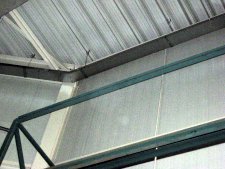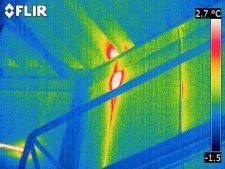Keeping your cool with thermal imaging
Monday, 02 December, 2013
Walk-in freezers can be energy-hungry at the best of times, but are even more so when they aren’t well sealed. To make sure a freezer’s insulation is working properly, thermographers inspect the insulation material with a thermal imaging camera.
“In essence, inspecting walk-in freezers, coldrooms and other types of large commercial refrigeration units is very similar to building insulation inspections,” said Dennis van Est, thermographer at the Thermografisch en Adviesbureau Uden in the Netherlands.
“The only difference is the direction of the heat. With building insulation inspections we generally try to detect heat leaking from the inside of the building to the outside air, but with refrigeration units we want to detect heat leaking inwards. But the mechanism of heat leakage is just the same.
“If there is any heat leakage this can cause a huge, unnecessary expenditure on energy bills. Detecting these heat leaks in an early stage allows the owner to fix the insulation defects, preventing soaring energy bills. With energy prices continually rising, the demand for walk-in refrigerator and freezer inspections is also growing.”


Van Est finds insulation problems in many of the walk-in freezers and coldrooms he is hired to inspect.
“You’d be surprised to see how often newly built refrigeration units have a faulty construction,” van Est said. “Sometimes the joints between the insulation panels are not protected properly, creating heat bridges. This can cause a lot of unnecessary energy consumption.
“In other cases older units might develop insulation faults over time due to wear. In both scenarios the best way to detect these insulation defects is by using thermal imaging cameras. Other methods, like spot pyrometers and such, really are not an option with this type of inspection. It is simply too easy to miss problems that you can relatively easily detect using thermal imaging.”
To van Est, the quality of the thermal imaging camera is crucial for these inspections.
“You need high-quality thermal images to be able to detect warmth bridges in the freezer insulation. The thermal sensitivity and accuracy are both very important, but to me the image resolution is also crucial. You need to be able to interpret what you see in the thermal image and if you are using a thermal imaging camera that produces thermal images at a resolution below the current industry standard of 640 x 480 pixels then you are missing a lot of information which you need in order to draw the right conclusions.”
According to van Est, the FLIR P640 thermal imaging camera is an excellent tool for these inspections.
“With an image resolution of 640 x 480, a thermal sensitivity of 30 mK (0.03°C) and an accuracy of ±2°C or ±2% of the reading, the thermal images produced by the FLIR P640 thermal imaging camera are of exceptionally high quality. This thermal imaging camera model is also very user-friendly. Especially if you compare it with the cameras of other manufacturers, the image quality and user-friendliness of the design are far superior.”
Another important thermal imaging camera feature for this particular application is the calibration range, van Est says.
“The FLIR P640 thermal imaging camera is calibrated to a minimum temperature of -40°C. This is very important to allow accurate temperature measurements. Most freezers are kept at a temperature between -20 and -30°C. However, even at temperatures just below the official calibration range, such as some exceptionally cold freezers that cool down their contents to -50 or even -60°C, the FLIR P640 thermal imaging camera is still quite capable of visualising insulation leaks.”
A good camera is only part of the solution, according to Ralf Grispen, commercial manager at the Thermografisch en Adviesbureau Uden.
“We therefore make sure that all of our inspectors have at least a level I thermography certificate from the FLIR Infrared Training Center (ITC) and preferably level II as well. For us this is one of the reasons why we chose FLIR - not only are the thermal imaging cameras of the highest quality, the accompanying training offered by the ITC is also very good,” Grispen said.
“High-quality thermal imaging cameras and good training come at a price, but they are definitely worth the money,” concluded van Est.
Resource-saving greenfield brewery being built in Germany
Designed with a 500,000 hectolitres/year capacity, a greenfield brewery is being constructed by...
Mars Wrigley Australia invests $6.5m to expand capacity at its Asquith factory
A new production line and circular-by-design packing technology have been introduced at the...
In good spirits: SRD's plans to transform iconic Oak factory site
On 21 March, at the historic former Oak factory site in Muswellbrook, Sydney Rum Distillery (SRD)...














